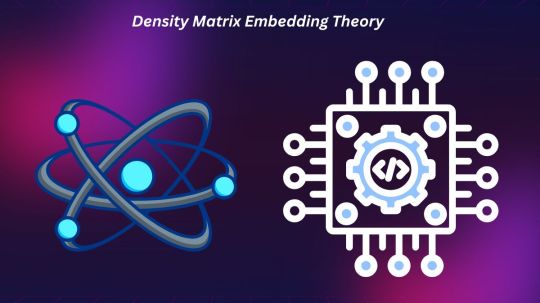#DensityMatrixEmbeddingTheory
Explore tagged Tumblr posts
Text
Density Matrix Embedding Theory & SQD for Quantum Modelling

Density Matrix Embed Theory
Combining Quantum Simulation Methods to Address Complex Molecules for Medical Progress
Michigan State University, IBM Quantum, and the Cleveland Clinic proved that hybrid quantum-classical techniques can accurately represent complex molecules using quantum computers, a major quantum chemistry breakthrough. Combining Density Matrix Embedding Theory (DMET) and Sample Based Quantum Diagonalisation (SQD), this groundbreaking finding advances quantum-centric scientific computing and has major health and medical implications.
Unlocked with Hybrid Quantum-Classical Power
Even the most advanced supercomputers have struggled to simulate huge molecule stability and behaviour, which is crucial for disease understanding and treatment. Modern high-performance computers cannot track over 33,000 molecular orbitals, which is needed to simulate insulin. Classical techniques fail as molecules increase larger. In addition, classical mean-field approximations fail to capture crucial electron interactions.
The first implementation of the SQD algorithm on genuine quantum hardware and incorporation into the Density Matrix Embedding Theory framework in this paper offers hope. This unique method, DMET-SQD, could replicate hydrogen rings and cyclohexane conformers. The DMET-SQD method replicates chemically important sections of a molecule instead than the entire molecule, which would need thousands of qubits. These fragments are then combined into an approximate electronic environment.
Quantum-centric supercomputing (QCSC) is defined by this “division of labour” between quantum and classical resources. The quantum processor in QCSC does the most computationally difficult operations, while regular high-performance computers handle the rest, including error correction. This hybrid technique allows state-of-the-art quantum computers without error-correcting capabilities to handle larger and more chemically realistic molecules. The Cleveland Clinic's IBM-managed quantum device, IBM Cleveland, the first of its type in the US, used 27 to 32 qubits in the study.
Real-World Accuracy Benchmarking
The researchers employed DMET-SQD to critically assess their hybrid technique on a ring of 18 hydrogen atoms and different cyclohexane conformers. Hydrogen rings are a standard benchmark in computational chemistry due to their high electron correlation effects, while cyclohexane conformers (chair, boat, half-chair, and twist-boat) are common in organic chemistry due to their narrow energy range, which makes them sensitive to even small computational
Heat-Bath Configuration Interaction (HCI), which may approach exact solutions, and Coupled Cluster Singles and Doubles with perturbative triples [CCSD(T)] were compared to quantum-classical results. The results were promising: DMET-SQD energy differences across cyclohexane conformers were within 1 kcal/mol of the best conventional reference methods, a standard chemical accuracy criterion.
For sufficiently large quantum configuration samples (8,000–10,000), DMET-SQD met HCI benchmarks for the hydrogen ring with negligible deviation while retaining cyclohexane conformer energy ordering. These results demonstrate that the technique may properly model physiologically relevant molecules despite hardware limitations.
Noisy Quantum Hardware Engineering Solutions
Practical usage of this embedding strategy on quantum technologies distinguishes the study. Modern quantum devices are noisy and unreliable. However, SQD's noise tolerance considerably reduced common errors. The authors stabilised calculations on IBM's Eagle processor via gate whirling and dynamical decoupling.
The team designed a custom interface to connect Tangelo's Density Matrix Embedding Theory library to Qiskit's SQD implementation. The simulation uses Hartree-Fock configurations encoded by each quantum circuit to maintain particle number and spin characteristics. These configurations were refined using S-CORE.
Future Outlook and Major Implications
Although the DMET-SQD technique is revolutionary, it has limitations and is still in its infancy. The fragment size and quantum sampling quality affect simulation accuracy. In systems with small energy changes or considerable electrical correlation, poor sampling may cause irregular energy ordering. The present study used a minimum basis set; chemically relevant applications will require more complex basis sets, qubits, and error control.
Study authors say more work is needed to improve sampling and reduce standard post-processing computer demand. Quantum hardware improvements in error rates and gate integrity will be crucial to scaling and enhancing these simulations.
This work suggests that hybrid quantum-classical approaches can handle real chemical processes better than “toy models.” Breaking full-molecule simulations into quantum computer-solvable subproblems allows scientists to solve previously intractable drug development and materials science problems.
Lead author Kenneth Merz, PhD, of the Cleveland Clinic, said, “This is a groundbreaking step in computational research that demonstrates how near-term quantum computers can advance biomedical research.” If they grow, DMET-SQD or similar hybrid techniques may anticipate novel materials, reaction mechanisms, and protein-drug interactions by accurately describing quantum effects in huge molecules. This breakthrough launches a new age of computational study that will directly help disease diagnosis and therapy.
#IBMQuantum#DensityMatrixEmbeddingTheory#quantumcentricsupercomputing#ibm#news#quantumhardware#hybridquantum#DMETSQD#technology#technews#govindhtech
0 notes